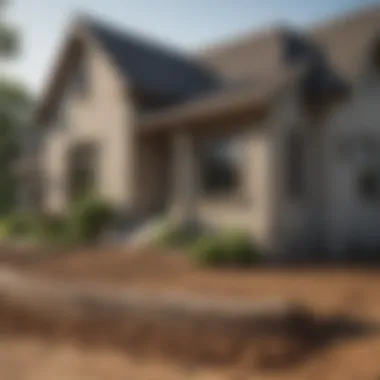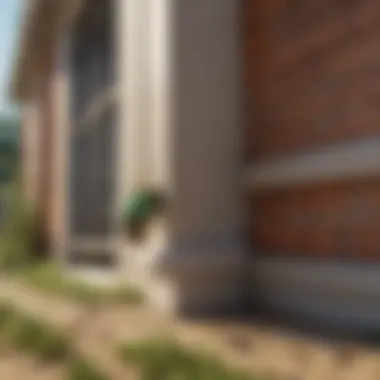Pest Control Strategies for New Homes


Intro
Pest control in new homes is a topic of increasing relevance as more people opt for newly constructed residences. This guide aims to navigate the complex landscape of pest management tailored specifically for these fresh builds. New constructions, while appealing for their modern designs, come with unique challenges and pest concerns.
Understanding the importance of early intervention cannot be overstated. Homes that are newly built attract pests that thrive in undisturbed areas. Thus, it is vital to be proactive in addressing this issue rather than reactive. Homeowners and builders should equip themselves with the knowledge of integrated pest management (IPM) techniques.
Effective pest control is not only about eliminating pests. It also involves a multi-faceted approach that includes prevention, monitoring, and maintenance. Recognizing the common pests that can invade new homes will help in establishing targeted strategies. This comprehensive guide will provide practical insights that are indispensable for homeowners and professionals alike.
Prologue to Pest Control in New Homes
Pest control is an important aspect for homeowners, particularly in newly constructed homes. When a house is built, it is susceptible to various pests that can infiltrate the living space. Understanding pest control ensures that these nuisances do not compromise the comfort, safety, and structural integrity of a home. The focus on pest control in new homes is vital due to numerous factors, such as the materials used in construction and the surrounding environment.
Understanding the Need for Pest Control
The need for pest control arises from the fact that newly constructed homes often attract pests searching for food and shelter. Common pests include termites, rodents, and ants, all of which can cause significant damage if not addressed early. The structural framework of a new home may still contain moisture from construction processes, making it appealing for many types of pests. Furthermore, landscaping and other outdoor features can create an inviting environment for infestations.
Homeowners must recognize that effective pest control not only protects their investment but also safeguards the health of occupants. Pests can carry diseases and allergens that pose health risks. Therefore, having a proactive pest control strategy is crucial for ensuring a safe living environment.
The Impact of Construction on Pest Activity
The construction of a new home significantly alters the surrounding ecosystem, which can lead to increased pest activity. During construction, the disruption of soil and vegetation can drive pests from their natural habitats into new structures. For instance, rodents may look for shelter as their burrows are disturbed. Additionally, certain building materials, such as wood and insulation, can serve as attractants for pests like termites and ants.
Moisture problems caused by construction also contribute to pest activity. Freshly poured foundations can take weeks to dry, creating ideal conditions for pests. If not managed, these issues can result in long-term infestations. Understanding this connection allows homeowners to take preventive measures early, thus managing potential risks effectively.
Common Pests in New Homes
Understanding common pests in new homes is vital for homeowners. Newly constructed houses, while modern and appealing, can attract various pests due to their open environments and proximity to building materials. Recognizing these pests early can aid in effective pest control and prevention strategies. This section delves into the most common pests and their implications for new homeowners.
Termites: The Silent Destroyers
Termites are often referred to as the silent destroyers, and for good reason. They can extensively damage the wooden structures of a home, often without visible signs until significant harm is done. Identifying signs of termite damage early on is crucial. Common indicators include:
- Hollow-sounding wood when tapped.
- Mud tubes on walls or foundations.
- Shed wings near entry points.
To prevent termites, proper construction practices must be adhered to, such as using treated lumber and ensuring good drainage around the home. Regular inspections are also recommended to catch any infestations early.
Rodents: A Growing Concern
Rodents are another common pest that can invade new homes. They often seek shelter from the elements and find easy entry through small openings. Mice and rats can cause significant damage by chewing on wires, insulation, and wood. Additionally, they pose health risks, as they can carry diseases that affect humans.
To combat rodent issues, sealing entry points is key. This includes:
- Checking for gaps around pipes and vents.
- Sealing cracks in walls and foundations.
- Storing food in secure containers.
Setting traps or seeking professional pest control services can help manage rodent populations effectively.
Ants: More Than Just a Nuisance
Ants may seem harmless at first, but they can quickly become a major issue in new homes. They usually enter homes in search of food and can quickly establish colonies if not addressed. Different species, such as carpenter ants, can also damage structural wood, making them a serious concern.
To prevent ant infestations:


- Keep food sealed tightly.
- Maintain cleanliness by promptly cleaning spills and crumbs.
- Identify and remove ant trails using soapy water.
Monitoring the perimeter of the home for nests can also aid in early detection.
Cockroaches: Disease Carriers
Cockroaches are well-known pests that thrive in warm environments, making new homes an ideal habitat. They reproduce quickly and can spread disease through their droppings and body parts. Heavy infestations can lead to respiratory issues and other health problems for occupants.
To minimize the risk of cockroach presence:
- Maintain a clean environment by regularly cleaning surfaces.
- Sealing cracks in walls and floors can reduce their access.
- Fixing leaks can deter them from seeking moisture sources.
Professional extermination may be necessary for severe infestations.
"Effective pest control in new homes requires both preventative measures and immediate action if a problem arises."
The End
In summary, understanding these common pests is crucial for new homeowners. By knowing what to look for and how to prevent infestations, one can protect their investment and ensure a healthy living environment.
Preventive Measures for Pest Control
Preventive measures are vital in maintaining a pest-free environment in new homes. Understanding how to proactively address potential pest issues is essential for homeowners. These measures not only save money but also protect health and well-being. Incorporating prevention strategies into the planning of a new home can minimize the risk of infestations.
Sealing Entry Points
Sealing entry points is one of the most effective measures in preventing pests. Pests can enter through small gaps and cracks around windows, doors, and foundations. Here are some common areas to inspect:
- Doors and windows: Ensure that all screens are intact. Consider using weather stripping for additional protection.
- Foundation: Check for cracks in the foundation and seal them with appropriate materials.
- Utility lines: Assess where utility lines enter the home. Use caulk to seal gaps around pipes.
By systematically inspecting and sealing these areas, homeowners can create a barrier against common pests.
Proper Waste Management
Proper waste management is another critical factor in pest control. Garbage and food waste attract various pests, including rodents and insects. Effective waste management strategies include:
- Regular trash disposal: Ensure that bins are emptied regularly and are fitted with tight lids.
- Composting: If using compost, keep it at a distance from the house and maintain it properly to avoid attracting pests.
- Food storage: Store food in airtight containers to prevent access to pests. Close pantry doors tightly.
By managing waste effectively, homeowners can reduce the likelihood of pest problems significantly.
Landscaping Considerations
Landscaping can influence pest activity around a home. It is important to plan the landscape in a way that minimizes pest attraction. Here are some key considerations:
- Plant selection: Choose plants that are less attractive to pests. Research pest-resistant varieties.
- Mulch and ground cover: Keep mulch at a minimum and avoid using wood chips close to the house, as they can harbor pests.
- Distance from structures: Maintain a distance between plants and the home’s foundations to reduce hiding spots for pests.
Landscaping with pest control in mind ensures a beautiful environment while minimizing potential infestations.
By implementing these preventive measures effectively, homeowners can create a robust defense against common pests, thus safeguarding their new homes.
Integrated Pest Management (IPM)
Integrated Pest Management (IPM) is a well-rounded approach to pest control that is particularly important for newly constructed homes. This method leverages a combination of strategies, ensuring that pest control measures are effective while minimizing potential harm to the environment and human health. For homeowners, understanding IPM is vital for achieving long-term pest control while addressing any immediate concerns like termites or rodents. The focus here goes beyond eradication to also include prevention, monitoring, and assessment.


Understanding IPM Principles
The principles of IPM revolve around several core concepts. Firstly, prevention is a major focus. By identifying potential pest entry points and regularly maintaining your property, one can reduce the likelihood of infestations before they begin. This can include measures such as keeping the yard tidy, managing waste properly, and sealing any cracks or gaps around your house.
Secondly, monitoring is critical. It involves regular checks for signs of pests and assessing environmental conditions that may attract them. This could be the moisture levels in your home or food sources that might be available to pests. By monitoring, you can determine if pest activity is increasing, which helps in making informed decisions about further actions.
Lastly, IPM emphasizes the use of biological and cultural control methods whenever feasible. This means promoting natural predators of pests or using traps instead of chemicals as the first line of defense. Such approaches not only limit the use of pesticides but also support a more sustainable way of living.
Monitoring and Assessment Techniques
Effective monitoring and assessment techniques form the backbone of any successful IPM plan. Start by conducting regular inspections around your home. Common areas to check are basements, attics, and crawl spaces, as they can easily harbor unwanted pests. Pay attention to signs like droppings, nests, or gnaw marks.
Utilizing tools such as sticky traps can also aid in monitoring specific pest populations. For example, placing these traps in strategic locations can help identify which pests are present and in what numbers. This data can inform not only immediate responses but also long-term management strategies.
Information from the assessments should be documented. This creates a valuable history of pest activity in your home, guiding future plans and interventions. Regular assessments also allow you to adjust your strategy quickly, ensuring that pest control remains effective and targeted.
"The efficacy of pest control is significantly enhanced when it is proactive rather than reactive."
Chemical vs. Non-Chemical Treatments
The choice between chemical and non-chemical pest control methods is pivotal in developing an effective pest management strategy for new homes. Understanding the implications and applications of each approach helps homeowners make informed decisions. This section evaluates the key aspects of both treatments, discussing their effectiveness, environmental impacts, and the importance of tailored solutions for specific pest problems.
Overview of Chemical Pest Control
Chemical pest control is widely known and encompasses a range of synthetic substances designed to exterminate pests. These chemicals include insecticides, herbicides, and fungicides, each targeting specific organisms with differing modes of action.
Here are some common chemical treatments:
- Insecticides: Effective against various insect pests, they can disrupt the nervous system of targeted insects.
- Rodenticides: Used primarily for rodent control, they poison rodents and can be lethal.
- Herbicides: Designed to eliminate unwanted plants, affecting their growth and reproduction.
While chemical pest control can yield immediate results, it raises concerns regarding safety for humans, pets, and other non-target organisms. Furthermore, repeated use of certain chemicals can lead to the development of resistance among pest populations. This means that over time, the same chemicals may become less effective, necessitating stronger or different formulations.
Benefits of Non-Chemical Alternatives
Non-chemical pest control methods are gaining traction as effective and eco-friendly alternatives. These approaches prioritize sustainability and can be better for long-term pest management. The benefits of non-chemical treatments include:
- Safety: Non-chemical methods reduce exposure risks to children and pets, enhancing the safety of your living environment.
- Environmental Considerations: These methods often have a lesser impact on ecosystems, protecting beneficial insects and wildlife.
- Cost-Effectiveness: Often, non-chemical approaches can be less expensive over time when considering the potential hazards and costs associated with chemical treatments.
- Sustainable Practices: Utilizing natural predators or organic deterrents supports more sustainable pest management.
Some effective non-chemical methods are:
- Physical Barriers: Installing screens and seals to prevent pest entry.
- Biological Control: Introducing natural enemies, like ladybugs for aphid control.
- Cultural Practices: Maintaining a clean environment that minimizes resources for pests, such as proper waste disposal and regular cleaning.
Non-chemical treatments may require patience and persistence but can significantly contribute to a balanced ecosystem at home.
Regular Maintenance and Monitoring
Regular maintenance and monitoring are integral components of effective pest control for new homes. By implementing a systematic approach, homeowners can not only prevent pests from becoming a problem but also quickly address any issues that arise. Establishing a routine for inspections aids in identifying vulnerabilities in the property, ensuring that pests are detected before they can cause significant damage.
Establishing a Routine for Inspections
Creating a detailed inspection routine can considerably improve the state of your home. Homeowners should inspect both the interior and exterior of the house regularly. Key elements to focus on include:
- Entry Points: Check windows, doors, and any gaps in the foundation. Make sure that these areas are sealed properly.
- Attics and Basements: These areas can be hotspots for pests, especially if they are cluttered or poorly ventilated.
- Landscaping: Ensure that plants and shrubs are not too close to the home, as they provide easy access for pests.


Conducting inspections every few months allows homeowners to take preventive measures based on what they observe. By staying proactive, issues can be addressed before they escalate to a major infestation.
Seasonal Considerations for Pest Control
Each season presents unique challenges for pest control. Understanding these variations can help in planning inspections and maintenance to align with seasonal pest activity. Factors to consider include:
- Spring: As temperatures rise, pests become active. Focus on prevention before infestations occur. Check for signs of termites or ants appearing in moist areas.
- Summer: This season often brings an influx of ants, wasps, and rodents. Regular inspections are crucial to identify new nests or burrows early.
- Fall: Rodent activity increases as pests seek warmth. Seal any potential entry points and inspect for signs of infestations.
- Winter: While some pests hibernate, others may seek shelter indoors. Monitor attics and basements for signs of unwanted guests.
A well-timed inspection schedule can make a significant difference in keeping a home pest-free throughout the year.
By committing to a strategy of regular maintenance and monitoring, homeowners ensure their new homes remain secure against potential pest threats.
Professional Pest Control Services
The significance of professional pest control services cannot be overstated, particularly for new homes. These services offer expertise and tools that are often beyond the average homeowner's reach. With newly constructed houses, there is a unique set of challenges concerning pest invasions. Since these homes can attract various pests, a proactive approach is essential.
A reputable pest control company brings valuable insights and experience to the table. They can assess the property and identify vulnerabilities that homeowners may overlook. This service goes beyond mere extermination; it involves creating a strategic plan tailored to the specific environment of the home. The benefits of engaging professional services are numerous:
- Expertise in Identifying Pests: Professionals can quickly identify pest species and the severity of infestations.
- Customized Treatment Plans: They devise treatment plans that are most effective for the specific types of pests and home layout.
- Access to Specialized Products: Many professional services use products that are more effective and often safer than those available to the public.
- Preventive Measures: They can advise on preventive strategies specific to the property, reducing the risk of future infestations.
Selecting a professional service involves careful consideration. A good pest control service not only resolves current issues but also manages the future of pest prevention in your home.
Choosing a Pest Control Service
When selecting a pest control service, several factors must be taken into account. First, consider their experience and reputation. Look for companies that specialize in residential pest control, particularly for new constructions. Online reviews, testimonials, and word-of-mouth referrals from neighbors can provide insight into the quality of service offered.
Additionally, ensure that the company is licensed and insured. This is crucial as it protects homeowners from potential liabilities. Ask about their methods for pest control. A trustworthy service will be transparent about the products used, showing a commitment to safety and efficacy.
Furthermore, inquire about warranties or guarantees provided by the company. A service that stands behind its work often reassures customers about their commitment and effectiveness. Pricing is also an essential factor, but it should not be the sole basis for making a decision. Remember, the cheapest option may not always offer the best results.
What to Expect from Professional Services
Upon hiring professional pest control services, homeowners can typically expect a comprehensive assessment followed by a systematic approach to treatment. Initially, a technician will visit the property to conduct a detailed inspection. During this inspection, they will look for signs of infestation, pest entry points, and conducive conditions for pest activity.
After the assessment, the technician will present their findings, discuss the appropriate treatment options, and explain the expected outcomes. It is common for them to implement a tailored treatment plan that may involve:
- Targeted Pest Control: Using methods specifically aimed at identified pests.
- Ongoing Monitoring: Setting up plans for regular follow-ups to monitor the efficacy of the treatments.
- Preventive Solutions: Providing actionable advice to reduce vulnerabilities and maintain a pest-free environment.
Homeowners should feel comfortable discussing their concerns and expectations, ensuring clarity on the process and follow-up actions. This communication is vital as it reinforces trust and sets the stage for successful pest management.
"An informed decision is key in maintaining the health and safety of your home environment through pest control."
In summary, professional pest control services are an essential component in managing pest-related issues in new homes. By choosing the right service, homeowners can rest assured that they are taking effective steps towards a pest-free living space.
Culmination
In pest control for new homes, the conclusion serves as a vital summary of essential strategies and best practices that have been discussed throughout the article. It reinforces the concept that prevention is both a strategy and necessity. By understanding the methods of pest management outlined, homeowners can take charge of their environments. This proactive approach leads to significant cost savings, and increased peace of mind regarding health and safety.
Recap of Key Considerations
Several key points stand out when considering pest control for new constructions. Firstly, understanding the need for pest control is crucial. Pests can thrive even in freshly built homes. Next, implementing preventive measures like sealing entry points and managing waste effectively creates an inhospitable environment for pests. Integrated Pest Management principles can offer effective, long-term solutions without relying solely on chemical treatments. Regular inspections and maintenance ensure any emerging issues are dealt with promptly. Choosing professional pest control services when necessary also provides expert insights that can help maintain a pest-free home.
The Importance of Proactive Pest Control
Proactive pest control is more than a reactive measure; it represents a fundamental shift in how we handle pest issues. Engaging in early intervention can mitigate the risks associated with infestations, which can otherwise lead to extensive damage and health problems. By focusing on prevention, homeowners create lasting defenses against pest activity. Moreover, implementing routine checks aligns with seasonal considerations that affect pest behavior, reinforcing an ongoing commitment to the home’s upkeep. This commitment contributes not only to the integrity of the physical structure but also to the overall well-being of its inhabitants.
"An ounce of prevention is worth a pound of cure."
In essence, taking pest control seriously from the beginning can shape the long-term success of maintaining a pest-free environment. Armed with the right knowledge and tools, homeowners can effectively protect their investments and ensure a healthy living space.







